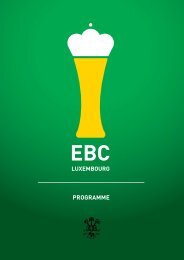please click here for download. - the 34th European Brewery ...
please click here for download. - the 34th European Brewery ...
please click here for download. - the 34th European Brewery ...
You also want an ePaper? Increase the reach of your titles
YUMPU automatically turns print PDFs into web optimized ePapers that Google loves.
P 053<br />
Sake fermentations:<br />
what can brewers learn<br />
P 054<br />
Unraveling <strong>the</strong> yeast flocculation<br />
mechanism at <strong>the</strong> molecular level<br />
P 055<br />
Worldwide breeding strategy <strong>for</strong><br />
LOX-less barley and characteristics<br />
of new Australian malting barley<br />
variety ‚Sou<strong>the</strong>rnStar‘<br />
Daniel Kerruish 1 , Trevor Phister 1 ,<br />
Ka<strong>the</strong>rine Smart 2<br />
1University of Nottingham, Nottingham, United Kingdom,<br />
2SABMiller plc, Woking, United Kingdom<br />
Francesco Ielasi 1 , Katty Goossens 1 ,<br />
Ronnie Willaert 1<br />
1Vrije Universiteit Brussel, Brussels, Belgium<br />
Makoto Kihara 1 , Wataru Saito 1 , Takehiro<br />
Hoki 1 , Takashi Iimure 1 , Naohiko Hirota 1 ,<br />
Masayuki Shimase 2 , Kiyoshi Takoi 2 , Jason<br />
Eglinton 3 , Shinji Yamada 1<br />
1SAPPORO BREWERIES LTD., Bioresources Research and<br />
Development Department, Gunma, Japan, 2 SAPPORO BRE-<br />
WERIES LTD., Product & Technology Innovation Department,<br />
Shizuoka, Japan, 3 The University of Adelaide, School of<br />
Agriculture, Food and Wine, Waite Campus, Australia<br />
DESCRIPTION OF TOPIC:<br />
Sake fermentations use rice, water and a<br />
co-culture of Aspergillus oryzae (Koji) and<br />
Saccharomyces cerevisiae (Kyokai) to achieve<br />
ethanol yields of up to 22%. Sake fermentations<br />
derive fermentable sugars from <strong>the</strong><br />
breakdown of polished rice by <strong>the</strong> exogenous<br />
enzymes produced by Aspergillus oryzae.<br />
These fermentable sugars are <strong>the</strong>n utilised by<br />
S. cerevisiae. Sake fermentations are t<strong>here</strong><strong>for</strong>e<br />
complex in nature and poorly understood.<br />
The purpose of this work is to understand <strong>the</strong><br />
reasons why Sake yeast are apparently so<br />
ethanol yielding and ethanol tolerant.<br />
T<strong>here</strong> are several possible reasons <strong>for</strong> this:<br />
fermentations are conducted with Aspergillus<br />
oryzae this mixed fermentation may be beneficial<br />
to <strong>the</strong> yeast; Sake yeast strains may<br />
also have a more effective ethanol defence. In<br />
this presentation <strong>the</strong>se two hypo<strong>the</strong>ses will<br />
be discussed.<br />
DESCRIPTION OF TOPIC:<br />
Yeast cell flocculation is exploited in <strong>the</strong> brewery<br />
industry as an easy and cost-effective<br />
way to separate <strong>the</strong> aggregated yeast cells<br />
from <strong>the</strong> beer at <strong>the</strong> end of <strong>the</strong> primary fermentation.<br />
The flocculation mechanism is<br />
based on a lectin-carbohydrate interaction,<br />
but was until recently not yet fully clear. The<br />
Flo adhesin family, in particular FLO1 and Lg-<br />
FLO1 gene products are lectins responsible<br />
<strong>for</strong> <strong>the</strong> Ca2+-dependent yeast flocculation<br />
phenotype. A biophysical study of <strong>the</strong> flocculation<br />
mechanism on <strong>the</strong> molecular level was<br />
carried out. The N-terminal carbohydratebinding<br />
domains of Flo1p from <strong>the</strong> ale yeast<br />
Saccharomyces cerevisiae and Lg-Flo1p<br />
from <strong>the</strong> lager yeast S. pastorianus were produced<br />
from suitable recombinant expression<br />
systems. Later on, a combination of protein<br />
crystallography, kinetic binding experiments<br />
and Single-Molecule Force Spectroscopy allowed<br />
us to refine <strong>the</strong> model <strong>for</strong> <strong>the</strong> binding of<br />
<strong>the</strong>se proteins to yeast cell-wall glycans.<br />
DESCRIPTION OF TOPIC:<br />
For years, people talk about <strong>the</strong> quality of<br />
draught beer and <strong>the</strong>ir potential <strong>for</strong> improvement.<br />
Developments in dispensing systems<br />
are, however, in most cases, just to improve<br />
<strong>the</strong> appearance of <strong>the</strong> equipment. The most<br />
important aspect <strong>for</strong> a brewer - hygiene - is<br />
often neglected. As a consequence, <strong>the</strong> quality<br />
of beer is destroyed in <strong>the</strong> last few meters,<br />
just be<strong>for</strong>e <strong>the</strong> consumer enjoys it.<br />
We carried out extensive studies on construction,<br />
cleaning and maintenance of dispensing<br />
equipment. It was found <strong>here</strong> that <strong>the</strong> microbial<br />
load in draught beer could be reduced by<br />
good hygiene practices in 6 weeks by more<br />
than 90%. The investigation of design aspects<br />
also brought strong improvements. Here also<br />
immense hygienic improvements were observed.<br />
The presentation shows <strong>the</strong>se findings and<br />
gives advice, such as fast recontaminations<br />
can be avoided and <strong>the</strong> draught beer quality<br />
can be improved. The presentation also will<br />
show <strong>the</strong> growth and sensorial influence of<br />
microbial infections in draught beer.<br />
Daniel Kerruish<br />
Francesco Ielasi<br />
Makoto Kihara<br />
Having gained a degree in microbiology from<br />
Liverpool University in 2001 and a PhD from<br />
Kings College London in 2007; Daniel spent 4<br />
years working as a technical brewer be<strong>for</strong>e<br />
fur<strong>the</strong>ring his research interests at <strong>the</strong> University<br />
of Nottingham. His current research<br />
interests are focussed upon sake fermentations<br />
and ethanol tolerance of yeast.<br />
PhD student at <strong>the</strong> Vrije Universiteit Brussel<br />
- VUB<br />
Since 1990: Research Scientist in <strong>the</strong> Plant<br />
Bioengineering Research Laboratories, Sapporo<br />
Breweries Ltd., Since 2009: Chief of Barley<br />
R&D center in <strong>the</strong> Bioresources Research<br />
and Development Department, Sapporo Breweries<br />
Ltd.. Since 1999: Doctor (Title of doctor<br />
<strong>the</strong>sis: Establishment of technique <strong>for</strong> <strong>the</strong><br />
production of transgenic plants using protoplast<br />
culture system in barley).<br />
62





